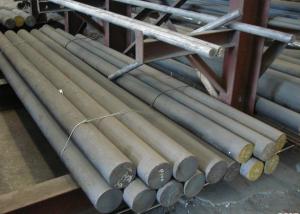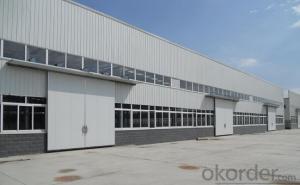Steel Round Bar Products
- Loading Port:
- Tianjin
- Payment Terms:
- TT or LC
- Min Order Qty:
- 25 Tons m.t.
- Supply Capability:
- 50000 tons per month m.t./month
OKorder Service Pledge
OKorder Financial Service
You Might Also Like
Specifications of Steel Round Bar Products
1. Grade: Q235, A36, SS400, S235JR
2. Feature: Unbreakable, grinding resistant and high impact value
3. Diameter: 8mm-150mm
4. Performance: Mainly for civil construction
5. Characteristics: Even hardness, no deformation, no breaking, no mal-roundness
6. Technique: Hot rolled
7. Mass: Mass (kg/m) = Diameter (mm) × Diameter (mm) × 0.00617
Usage and Applications of Steel Round Bar Products
1. Steel round bar products is used in construction and a large number of architectural and engineering structures. And it can be used in production of handrail, windows, machinery, telecom and curtain wall.
2. It can be used in the fields like metal mines, cement plants, water coal slurry, power stations and chemical industry.
3. Besides, we can supply some especial material steel round bar that can be used for main shaft of steamer, hummer shank, with big section and supper force.
4. Recommended watchcase factory, screw factory and other cold stamping products industry use.
Packaging & Delivery of Steel Round Bar Products
Packaging Detail: All goods are packed in bundle with steel strips and shipped by break bulk vessel or container (depend on target market and different ports)
Delivery Detail: 45 days
Trade terms: FOB, CFR, CIF
MOQ: 25 tons per specification; we can negotiate the quantity if the specification is normal or we have stock of one specification.
Weight: The price invoicing on theoretical weight basis or actual weight basis depends on customer’s request.
Shipment: The shipment of bulk break or container is depends on customer’s request and the situation of the port of destination.
Documents given: Full set of original clean on board bill of lading; Original signed commercial invoice; Original packing list; Policy of insurance; Certificate of origin and what the target market needs.


Production Flow of Steel Round Bar Products
Material prepare (billet) — heat up — rough rolling — precision rolling — cooling — packing — storage and transportation
Characteristics of Steel Round Bar Products
1. The steel in which the main interstitial alloying constituent is carbon in the range of 0.12–2.0%.
2. As the carbon percentage content rises, steel has the ability to become harder and stronger through heat treating; however it becomes less ductile.
3. Regardless of the heat treatment, higher carbon content reduces weld ability. In carbon steels, the higher carbon content lowers the melting point.
4. Quality should be in conformity with the specification of the manufacturer. Quantity and packing conditions should be in conformity with the term in the contract.
- Q:How are steel structures designed to be resistant to impact from projectiles?
- Steel structures are designed to be resistant to impact from projectiles through several key design principles. Firstly, the choice of materials is crucial. High-strength steel is often used for structures that need to withstand projectile impacts. This type of steel has exceptional strength and toughness, making it highly resistant to deformation and fracture. Additionally, steel can be reinforced with other materials such as carbon fiber composites or laminates to further enhance its impact resistance. Secondly, the design of the structure itself plays a significant role in its ability to withstand projectile impacts. Steel structures are typically designed with redundant load paths and robust connections to distribute and dissipate the impact force. This helps prevent concentrated stress points that could lead to failure upon impact. Furthermore, engineers carefully consider the shape and geometry of the structure to minimize the risk of projectiles finding weak points or causing excessive damage. Additionally, energy absorption mechanisms are incorporated into the design. These mechanisms can include sacrificial elements or specially designed features that absorb and dissipate the impact energy. For example, sacrificial plates or sections can be strategically placed to absorb the initial impact and protect the critical components of the structure. Similarly, buffer zones or deformable elements can be introduced to help absorb and disperse the energy from the projectile. Moreover, computer-aided simulations and modeling techniques are extensively utilized in the design process. Advanced finite element analysis and computational fluid dynamics are employed to accurately predict the behavior of steel structures under projectile impact scenarios. This allows engineers to optimize the design, identify potential weaknesses, and make necessary modifications to improve the impact resistance of the structure. Lastly, rigorous testing and certification processes are conducted to ensure the structural integrity and impact resistance of steel structures. These tests involve subjecting the structure to various impact scenarios using projectiles of different sizes and velocities. By analyzing the results and comparing them to established standards and guidelines, engineers can validate the design and make any necessary adjustments to meet the required resistance levels. In summary, steel structures are designed to be resistant to impact from projectiles through the use of high-strength materials, robust structural design, energy absorption mechanisms, computer simulations, and rigorous testing. These measures collectively ensure that steel structures can withstand projectile impacts and maintain their structural integrity.
- Q:What are the different types of steel access platforms?
- There are several types of steel access platforms available, including fixed access platforms, mobile access platforms, folding access platforms, and adjustable access platforms.
- Q:Why can't epoxy paint be used in outdoor steel structures?
- Epoxy paint used as primer, iron red epoxy primer, epoxy zinc primer can be matched with acrylic polyurethane paint, fluorocarbon paint, etc. for outdoor weatherproof coating.
- Q:What are the different types of steel modular buildings?
- There are several different types of steel modular buildings, including single-story buildings, multi-story buildings, portable buildings, temporary buildings, and permanent buildings. These structures can be designed for various purposes such as offices, schools, hospitals, residential units, and even industrial facilities. The flexibility of steel modular construction allows for customization and scalability to meet specific needs and requirements.
- Q:How are steel structures used in the construction of cinemas?
- Due to their strength, durability, and versatility, steel structures are commonly employed in the construction of cinemas. Steel proves to be an excellent material for constructing spacious cinema auditoriums, as it can handle heavy loads and span long distances without the need for obstructive columns or supports that might impede the view of the screen. The cinema building's skeleton is often formed using steel frames, which create a robust and stable structure capable of withstanding external forces like wind and earthquakes. The steel beams and columns are meticulously designed and engineered to ensure that the roof, walls, and other components can be safely supported. Not only is steel utilized in the main structure, but it also finds its way into various other cinema elements. For instance, steel is frequently employed in the framing of cinema screens, providing a rigid and stable surface for movie projection. Additionally, steel is used in constructing staircases, balconies, handrails, and other architectural features within the cinema. Furthermore, steel is an environmentally friendly and sustainable choice for cinema construction. As a recyclable material, steel aids in reducing the building's overall carbon footprint. Moreover, steel structures can be prefabricated off-site, thereby reducing construction time and minimizing disruption to the surrounding area. In conclusion, the construction of cinemas heavily relies on steel structures, which provide a sturdy, long-lasting, and adaptable framework that can cater to the unique requirements of these entertainment venues.
- Q:What are the design considerations for steel structures in seismic zones?
- Design considerations for steel structures in seismic zones include: 1. Seismic forces: Steel structures must be designed to resist the forces generated during an earthquake. The design should consider the expected magnitude and frequency of seismic activity in the area. 2. Ductility: Steel structures should be designed to exhibit adequate ductility, meaning they can undergo significant deformation during an earthquake without collapse. This allows the structure to absorb and dissipate seismic energy. 3. Connections: The connections between steel members need to be carefully designed to ensure they can withstand the seismic forces. Special attention should be given to the strength, stiffness, and redundancy of these connections. 4. Structural framing: The overall structural framing system should be designed to provide a robust and stable framework. This may involve using moment-resisting frames, braced frames, or other systems that can effectively distribute and dissipate seismic forces. 5. Load paths: The load paths within the structure need to be well-defined to ensure that seismic forces are properly transferred from the roof to the foundation. This may involve designing for both vertical and lateral loads to ensure stability during an earthquake. 6. Foundations: The design of the foundation system should consider the site-specific soil conditions and the dynamic response of the soil during an earthquake. The foundation should be able to resist both vertical and lateral loads. 7. Seismic codes and regulations: Designers must adhere to relevant building codes and regulations specific to seismic zones. These codes provide guidelines for designing structures to resist seismic forces and ensure the safety of occupants. Overall, the design of steel structures in seismic zones requires careful consideration of the expected seismic forces, structural behavior, connections, load paths, foundations, and compliance with relevant codes and regulations.
- Q:How does steel compare to other construction materials, such as concrete or wood?
- Steel is often considered the superior choice when compared to other construction materials like concrete or wood. One of the main advantages of steel is its unmatched strength and durability. It has a high tensile strength, allowing it to withstand heavy loads and resist deformation or structural failure. In comparison, concrete has good compressive strength but lacks the same tensile strength as steel, requiring steel reinforcements to overcome this limitation. Wood, on the other hand, has lower strength and is prone to warping, rotting, or termite damage over time. Additionally, steel offers exceptional versatility in construction. It can be easily molded into various shapes and sizes, allowing for complex architectural designs and flexible construction methods. This adaptability makes steel an ideal material for large-scale projects and unique structures. Steel is also highly resistant to fire, making it a safer choice for construction. It has a high melting point, which means it retains its structural integrity for a longer time during a fire incident. In contrast, wood is highly flammable, while concrete can crack or explode when exposed to high temperatures. Moreover, steel is an environmentally friendly option. It can be recycled indefinitely without losing its properties, reducing the demand for new materials and minimizing waste production. Concrete, on the other hand, requires significant amounts of energy for production, and wood comes from deforestation practices that harm the environment. Despite its numerous advantages, steel does have some drawbacks. It is more expensive than concrete or wood, making it less feasible for smaller-scale projects or budget-constrained situations. Steel structures also require skilled labor and specialized equipment for fabrication and construction, which can increase the overall cost. In summary, steel outperforms other construction materials due to its unparalleled strength, durability, versatility, fire resistance, and sustainability. While it may have higher costs and require specialized expertise, its benefits make it a preferred choice for many construction projects.
- Q:What are the design considerations for steel public infrastructure?
- Several important considerations must be taken into account when designing steel public infrastructure. Firstly, the utmost importance lies in the structural integrity of the steel structure. The design needs to ensure that the infrastructure can withstand the various loads it will experience over its lifespan, including weight, wind, seismic activities, and other environmental conditions. This requires careful analysis and calculations to determine the appropriate size and strength of the steel components. Another factor to consider is the durability and resistance to corrosion. Steel structures in public infrastructure are often exposed to harsh weather conditions, moisture, and other environmental factors that can lead to corrosion and deterioration. Therefore, it is necessary to implement proper coating systems and maintenance practices to protect the steel from corrosion and ensure its long-term performance. Furthermore, aesthetics and architectural considerations have a role to play in steel infrastructure design. Bridges, stadiums, and train stations, which are examples of public infrastructure, often serve as landmarks or visually significant elements in urban landscapes. Therefore, the design should take into account the desired visual appearance, blending harmoniously with the surrounding environment while also meeting functional requirements. In addition to these considerations, sustainability is becoming increasingly important in the design of public infrastructure. Steel is a highly recyclable material, and its use can contribute to reducing the carbon footprint of the project. Designers should aim to optimize the use of steel, minimize waste, and consider the life cycle of the structure to ensure its environmental impact is minimized. Lastly, cost-effectiveness is an important consideration in steel infrastructure design. The design should aim to optimize the use of materials, reduce construction time, and minimize maintenance and operational costs. This requires careful planning, efficient design strategies, and collaboration between engineers, architects, and construction professionals. To conclude, the design considerations for steel public infrastructure encompass structural integrity, durability, resistance to corrosion, aesthetics, sustainability, and cost-effectiveness. By addressing these considerations carefully, designers can create steel structures that are not only safe and functional but also visually appealing, environmentally friendly, and economically viable.
- Q:What is the role of steel in the construction of stadiums and arenas?
- Steel plays a crucial role in the construction of stadiums and arenas as it provides the necessary structural support and durability required for these large-scale structures. It is commonly used in the framework, roofing, and seating areas, allowing for wide spans and open spaces. Steel's strength and versatility enable architects and engineers to design unique and innovative stadium structures, ensuring the safety and comfort of spectators while optimizing the overall aesthetics of the venue.
- Q:What are the key factors influencing the design of steel structures?
- The key factors influencing the design of steel structures include the intended use of the structure, the loads it will be subjected to, the available materials and their properties, the local climate and environmental conditions, the desired aesthetics, and the applicable building codes and regulations. Furthermore, factors such as cost, construction methods, and future expansion or modification possibilities also play a significant role in determining the design of steel structures.
1. Manufacturer Overview |
|
|---|---|
| Location | Hebei, China |
| Year Established | 1995 |
| Annual Output Value | Above US$ 15 Million |
| Main Markets | Middle east; Southeast Asia; Africa; East Aisa |
| Company Certifications | |
2. Manufacturer Certificates |
|
|---|---|
| a) Certification Name | |
| Range | |
| Reference | |
| Validity Period | |
3. Manufacturer Capability |
|
|---|---|
| a)Trade Capacity | |
| Nearest Port | Tianjin |
| Export Percentage | 20%-35% |
| No.of Employees in Trade Department | 11-20 People |
| Language Spoken: | English; Chinese |
| b)Factory Information | |
| Factory Size: | Above 6,500 square meters |
| No. of Production Lines | 1 |
| Contract Manufacturing | OEM Service Offered |
| Product Price Range | Average |
Send your message to us
Steel Round Bar Products
- Loading Port:
- Tianjin
- Payment Terms:
- TT or LC
- Min Order Qty:
- 25 Tons m.t.
- Supply Capability:
- 50000 tons per month m.t./month
OKorder Service Pledge
OKorder Financial Service
Similar products
New products
Hot products
Hot Searches
Related keywords



























